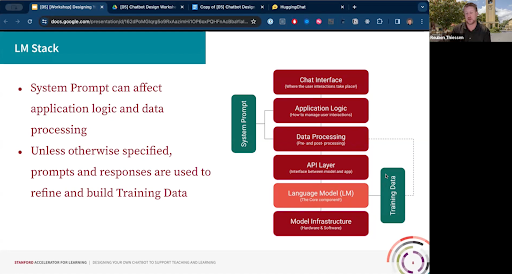
In a world where artificial intelligence (AI) is rapidly advancing, chatbots have become an intriguing “on-ramp” for non-experts to learn about AI first-hand. Recognizing this, we developed and iterated a workshop, Design Your Own Chatbot, to empower those in education to build their own versions of AI and, through this process, decide for themselves the promise and pitfalls of AI in the classroom. This workshop evolved over time, and our team captured insights along the way about how to set up a hands-on learning experience where participants could more deeply understand AI – and develop their own custom chatbot – in 90 minutes.
The Design Your Own Chatbot workshop has seen a few iterations, each version tailored to the most up-to-date AI tools as well as the needs of participants. The first version was implemented by Josh Weiss, Director of Digital Learning Solutions at GSE IT, at the Seminar on Generative AI and Education in Spring 2023. As the technology evolved, a second version sprung up as part of the Stanford Accelerator for Learning (SAL) AI workshop series, which was led by Reuben Thiessen, Emerging Technology Lead.
As the workshop became more outward-facing, a third version was implemented at the ASU-GSV AIR show in April 2024. This was one of the top attended sessions, with standing room only for a room of 150 people (see picture). This iteration, tailored specifically for K-12 educators, was co-facilitated by Josh and Reuben, as well as SAL Senior Research Scholar Cathy Chase and d.school Managing Director Laura McBain, with support from Professor Susanna Loeb, SAL Executive Director Isabelle Hau, and a team of staff and students.
By the end of each workshop, participants were expected to have an entry-level understanding of AI tools and a prototype chatbot ready for professional or personal use. This objective set the stage for a dynamic, engaging workshop encouraging critical and creative thinking about AI-driven chatbots.

Being intentional about the audience was the first step. While the primary audience was educators, we aimed to attract a diverse group, including school administrators, tech enthusiasts, and parents. This diversity required the workshop to be accessible yet challenging enough to engage participants with varying technical expertise. As a result, the experience was designed around three key components:
- Introduction to AI and Chatbots: A brief overview ensuring all participants had a foundational understanding of the technology.
- Design Principles of Chatbots: Focusing on the essential elements that make chatbots effective and user-friendly.
- Hands-On Time: Guiding participants through designing and programming their chatbot using simple tools and templates.
In later versions, the workshop structure took on four distinct stages:
- Chatbot Design Framework: Teaching the fundamental components of a chatbot, including user intents, crafting responses, and building a conversational flow.
- Meta-Prompt Crafting: Guiding participants on crafting meta-prompts that shape the chatbot’s behavior, emphasizing precise language and clear instructions
- Testing and Refining: Allowing participants to test their chatbots in real-time, receive feedback, and refine their designs.
- Sharing and Feedback: Providing a platform for participants to showcase their chatbots, discuss design choices, and receive peer feedback.
By the end of the workshop, participants not only understood chatbot technology but they also had firsthand experience in designing, building, and refining their chatbots. This structure instilled confidence in applying these new skills in various contexts.

Selecting the right tools was crucial for the workshop's success. Most recently, we used the Hugging Face Assistants framework for accessibility: it is free to use, the interface does not require any coding, and it offers a range of simple-to-complex chatbot configurations.
While Hugging Face was the primary tool, we also experimented with platforms like OpenAI and Poe to showcase different AI capabilities. This helped participants understand the variety of tools available and choose the right one for their future projects.
Participants walked away with a variety of resources to aid their learning, beginning with templates and scripts as starting points for customizing their chatbots. They also received access to extended learning materials like tutorials, forums, and articles for continued exploration of AI and chatbot technology.

The feedback was overwhelmingly positive. Participants appreciated the practical skills acquired, with one noting: "Each element of your team's presentation could have been a separate workshop. The design of the session, use of space, and the materials were all top-notch."
Upon reflection, the team agreed on the importance of flexible teaching methods to adapt to different learning environments and participant needs. Moreover, the need for clear and concise presentation styles was crucial to maintain engagement, especially in virtual settings. Finally, the team recognized the value of practical, hands-on activities that reinforce learning and allow immediate application of concepts.
The workshop concluded with participants sharing their chatbots, ranging from educational tools to customer service assistants. This showcase demonstrated the diverse applications of chatbots and allowed participants to receive constructive feedback from peers and facilitators.

